Texto extraído do verso das Estampas
Das Coleções do Rio de Janeiro
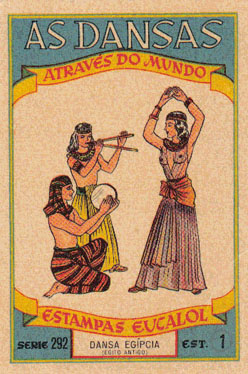
DANÇA
EGÍPCIA
(Egito Antigo)
No
início, as danças do Egito antigo, religiosas e mitológicas,
perdem pouco a pouco seu caráter sagrado e nacional.
No tempo do “Reino Novo” (1500 a.de J.C.) as danças
aparecem apenas como exibições artísticas ou acrobáticas,
executadas pelas dançarinas profissionais.
EGYPTIAN DANCE
(Ancient Egypt)
In
the beginning, the dances of ancient Egypt, religious and mythological,
gradually lose their sacred character and national levels.
During the "New Kingdom" (1500 a.de JC) dances appear only as
art exhibitions or acrobatics, performed by professional dancers.
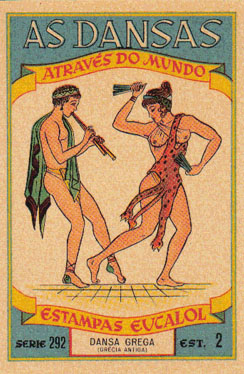
DANÇA
GREGA
(Grécia Antiga)
As
danças gregas apresentam duas formas distintas: danças sagradas
e danças ginopédicas.
Enquanto as danças sagradas, executadas exclusivamente por mulheres,
guardam um caráter de magia enobrecida, os guerreiros, os jovens
atletas desnudos e moças em trajes masculinos se entregam com alegria
aos encantos das danças ginopédicas.
GREEK
DANCE
(Ancient Greece)
The
Greek dances have two distinct forms: sacred dances and "ginopedic"
dances.
While the sacred dances, performed exclusively by women, keep a magic
ennobled character, warriors, nude athletes and young girls in men's clothes
give themselves joyfully to the charms of the ginopedic dances.
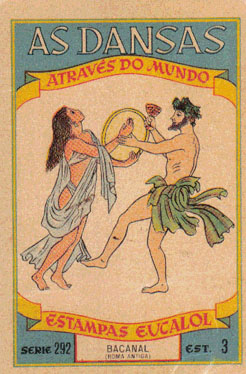
BACANAL
(Roma Antiga)
Este
nome foi dado pelos Romanos às festas orgíacas do mito dionisíaco
ou Báquico. No começo, eram danças de iniciação
mas pouco a pouco tomaram um caráter orgíaco e desenfreiado
de tal forma que o senado romano teve que proibi-las.
São a origem do nosso moderno Carnaval.
BACCHANAL
(Ancient Rome)
This
name was given by the Romans to orgiastic parties of Dionysian or Bacchic
myth. In the beginning, there were dances of initiation but gradually
took an orgiastic character and recklessness in such a way that the Roman
Senate had to ban them.
Are the origin of our modern Carnival.
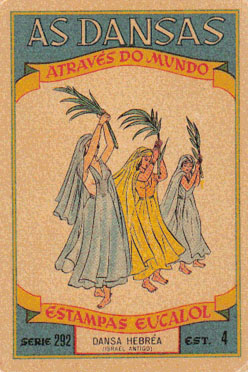
DANÇA
HEBRÉA
(Israel Antigo)
Dança
sagrada que se realiza no dia do Perdão.
As moças hebréas, vestidas de cores claras, dançavam
dentro das vinhas sob a admiração dos rapazes que escolhiam
futuras esposas.
HEBREW DANCE
(Ancient Israel)
Sacred
dance which is held on the day of Atonement.
Hebrew girls, dressed in bright colors, danced in the vineyards in the
admiration of the boys who chose future wives.
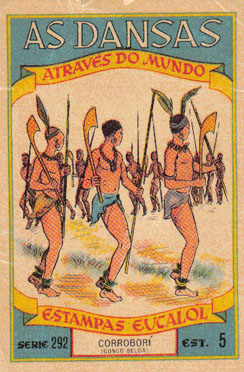
CORROBORÍ
(Congo Belga)
O
corroborí é um baile ginástico comum a todos os povos
de vida primitiva.
O corroborí se dança quase sempre de noite, principalmente
ao luar, para festejar acontecimentos importantes da vida da tribo.
(brasilcult)
ORROBORÍ
(Belgian Congo)
The
corroborí is a gymnastic dance common to all peoples of primitive
life.
The corroborí is danced almost always at night, especially in the
moonlight to celebrate important events in the life of the tribe.
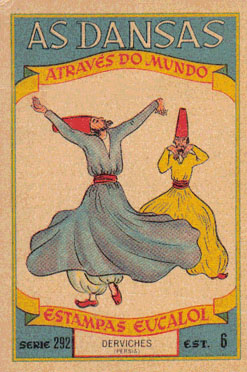
DERVICHES
(Pérsia)
Antes
de tornar-se um passatempo autorizado, a dança era sobretudo um
ato sagrado e um mistério sacerdotal.
No verso um exemplo de dança religiosa extática dos persas:
fanáticos muçulmanos da seita dos sufistas. A sua dança
consiste em girar.
DERVISH
(Persia)
Before
becoming an authorized hobby, especially the dance was a sacred act and
a priestly mystery.
On the back is an example of religious ecstatic dance of the Persians:
fanatical sect of Sufi Muslims. Their dance consists in turning.